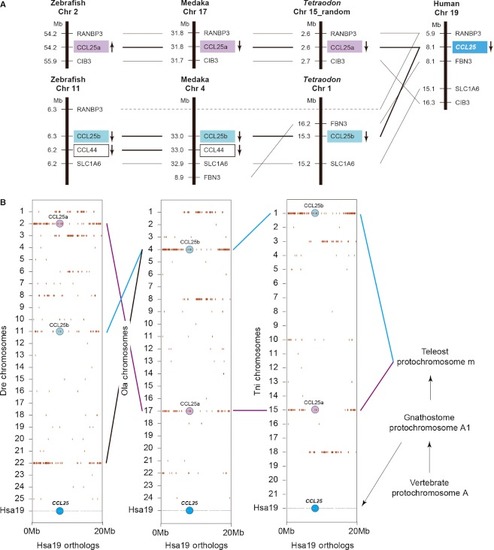
Conserved synteny analysis of vertebrate chemokine CCL25. (A) Comparative maps of CCL25 gene regions. Fish-specific CCL44 genes are also shown. Arrows indicate transcriptional orientation. Comparative maps of other chemokine and chemokine receptor genes are shown in Fig. S3 in Supporting Information. (B) Conserved synteny dot plots. The plots were drawn using the Synteny Database (Catchen et al. 2009, 2011). In the plots, fish orthologs of genes on Hsa19 (0–20 Mb) are indicated as red crosses on fish chromosomes in the order found on the human chromosome (gene orders on fish chromosomes are different from those of humans). Correspondence of the chromosomes among teleosts containing the CCL25 genes was examined as follows. First, the CVL number was obtained using the human CCL25 gene locus (chromosome 19, 8.1 Mb) (Nakatani et al. 2007). Supplemental Fig. S2 in reference 20 shows that the human genes in this CVL block “88” are orthologous to the genes on medaka chromosomes 4 and 17, where the two medaka CCL25 genes are located. Next, protochromosome numbers of the teleost, gnathostome, and vertebrate ancestors (m, A1 and A, respectively) were identified from Supplemental Table S2 in reference 20. Using the teleost protochromosome number, the orthologous chromosomes of the three teleosts were then identified in the Supplemental information of reference 25. In case of teleost-specific genes, teleost protochromosome numbers and correspondence of the chromosomes in each teleost can be obtained by consulting the Supplemental information in reference 25. Dre2, Ola17, and Tni15, all containing CCL25a, were derived from one of the duplicated chromosomes of teleost protochromosome m. Dre11, Ola4, and Tni1, all containing CCL25b, were derived from another duplicated copy of the same protochromosome. Dre11 and Dre22 are the products of chromosome fission. Human and teleost chromosomes containing the CCL25 regions were all derived from gnathostome protochromosome A1 and also from vertebrate ancestral chromosome A (see also Fig. 4). Synteny dot plots of other chemokine and chemokine receptor genes and the CVL numbers are shown in Fig. S5 and Table S4 in Supporting Information, respectively.
|

